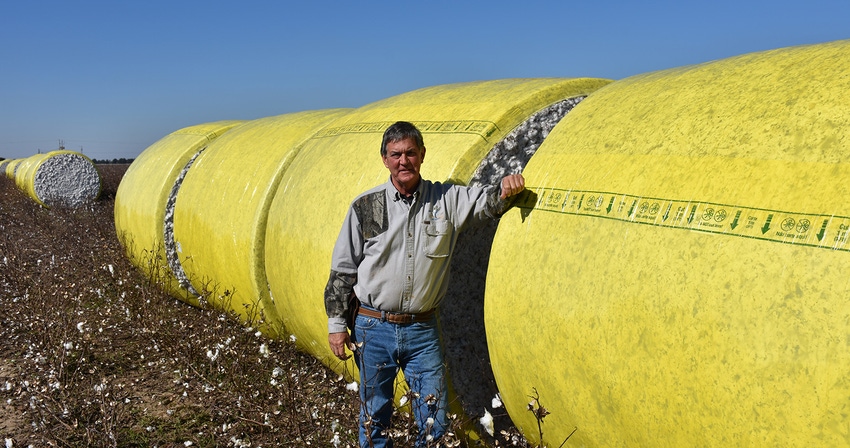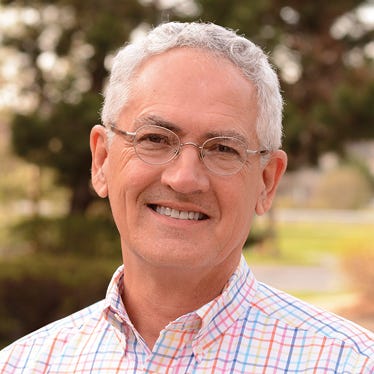
John Lindamood's cotton operation is certainly tied to technology, but he doesn't suggest getting too far out in front of it.
"You don't want to be too cutting edge," he said. "It's like the old Beta VCR technology. You don't want to get out too far ahead because you don't want to invest in hardware and software and then have it disappear."
He seems to do a good job processing the data that he does collect, as well as manage his operation that relies a great deal on sustainable practices, which are just a couple of the reasons he has been named the Midsouth's recipient of the High Cotton Award for 2022.
"Any year we'll be anywhere from 25% to 50% in cotton," he said. "I like to be more biologically diversified. This year we had 2000 acres of cotton and next year we'll probably be back up to 2,500, maybe 3000, depending on cotton and commodity prices."
It is a family operation involving his three sibling and mother, however Lindamood and his farm manager Daniel Arant manage the daily operations of the farm and gin.
Lindamood's father, Bill, was involved in the operation until about a year ago when he passed away.
"He was still active and up until the last year he was in the office every day," Lindamood said. "The last year of his life, he was on the phone every morning when we'd have our marketing meetings. He was still involved giving his suggestions and thoughts."
John grew up on the farm and attended Murray State University with an eye on a different career path. After graduating with a degree in business administration, he and his wife, Cherry, opened a restaurant. When the restaurant closed, he considered going back to school.
"I had no intention of farming. That was not on my agenda," Lindamood said. "I was faced with the choice of either going to culinary school, which is what I really wanted to do or coming home and farming. That was in the early '80s."
Farming was tough at that time. Growers were still feeling the effects of the drought of 1980 and interest rates were high. His dad was considering retiring but told John that if he wanted to come back, he would stay until the farm could support itself.
"I had a wife and a child and a business that we had just closed," Lindamood said. "And so, it seemed like the thing to do. That was what, 38 years ago or so."
Tillage
Bill Lindamood was already growing a little bit of no-till wheat and beans.
The Lindamoods adapted the technology to one of their sprayers. Commercial hooded sprayers hit the market in the mid-1990s. In the early 2000s Roundup Ready technology was introduced, paving the way for a broader use of no- and low-till cropping systems.
"So, we've been pretty much no-till farmers across the board since the mid-90s," he said.
Since 2016 Lindamood has adopted Phytogen's Enlist varieties of cotton in his operation.
"We were looking this year at some ThryvOn and some of the Bayer varieties," he said. "We participated in a variety trial for them and are anxious to see the outcome of those. So, we haven't closed any doors.
"Our yields are going to be really good this year. That's one very bright spot. We have averaged about 1,250 pounds of cotton for the last six years. This year we're on target to be better than average. We're gonna exceed that average this year."
Repair work
Every year he does a limited amount of tillage to heal ruts and damage to the ground. He runs a minimally invasive tool called a Turbo-Till. It works the soil at varying depths anywhere from an inch to two inches. The pitch on the gangs can be set to work from zero to 6 degrees, which allows the operator to run it right on top of the ground to size the residue or to bust the crust up and prepare the planting zone.
Cover crops are a good fit for some of his lighter ground.
"Out of the 5,000 acres we farm, we've had a cover crop every year of about 1,000 acres," he said. "That's in addition to any wheat crop that we've got. We find tremendous benefits in our lighter, sandier, well-drained soils."
He has seen yield enhancements of 25 to 30% that he attributes to the use of the cover crops in the sandier soils. He uses cereal rye and vetch as his cover. The vetch fixes nitrogen which is helpful where it is used and the cover shades out small weeds.
Labor
As farming becomes more technical and inputs become more finely tuned, the amount of labor needed to run an operation like Lindamood's has lessened, but the skill of those employees has become more important.
Those kinds of employees are difficult to find, but he said that his operation has been blessed to have some good, skilled employees. As attrition or retirement takes place, he is looking to replace those employees with young people who are willing to roll up their sleeves and get to work.
"We have one new employee we hired right out of college," he said. "We helped him with his tuition and room and board. In exchange he agreed to work for us for a couple of years after he graduated. We hope that it's a long-term position because he certainly brings a lot to the table and it's a good fit for both sides."
The technical nature of today's agriculture necessitates that those who interface with the data collected on the farm are able to manage it in order to use it affectively.
"We got into precision ag over 20 years ago," Lindamood said. If you define precision ag as site-specific applications of resources, we've been doing that since the mid-90s using rudimentary soil analysis and physical landmarks."
Technology
In the early 2000s companies began marrying that technology with remote imaging and the internet. It provided real-time solutions within reasonable time for applications.
"The lightbulb went off, let's do it," he said. "We were taking iPads and piggybacking them on our spray systems. It was pretty involved."
He said that the process has evolved now to every piece of equipment that a producer can buy – autosteer GPS that interfaces with product application in a site-specific manner.
"We've progressed over the years," he said. "But, with progression we found we need to have better budgetary controls in what we do to stay on top of things."
"Throughout the year, you can use granular to assign work orders," Lindamood said. "All our employees have smartphones and they access it through an app. They pull up their work orders and initiate the work, verify the applications and complete the work all on their phone."
All the information is transmitted back to the office, replacing what was previously done with handwritten notes and transferring it into spreadsheets.
"Being able to assign work, have our employees open their phones, do the work, verify the inputs and complete the work and having all that inputted into our records seamlessly is tremendously beneficial from a logistics standpoint," he said. "But also very beneficial from a budgetary standpoint."
Crop plans are formulated and put into the system. Each year that crop plan is reviewed and tweaked, then transferred to the next year.
"Every day brings changes and it's a flexible program in managing those changes to your crop plan. It makes it pretty easy," he said.
It's key to the sustainability of his entire operation.
"I've always said that sustainability is like a three-legged stool," he told Farm Press in November. "You've got to have all three legs or it just doesn't function.
"He notes that it must be environmentally sustainable, socially sustainable and economically sustainable.
"They all complement each other," he said. "The product, the processes and procedures that we use that are economically viable on our farm are also environmentally sound, looking after our employees, health and safety. Our impact on the community has environmental and economic benefits to us."
About the Author(s)
You May Also Like






